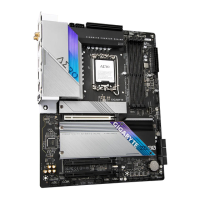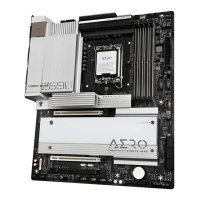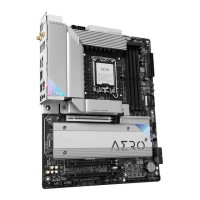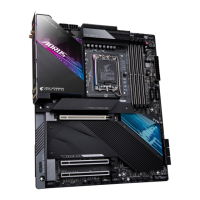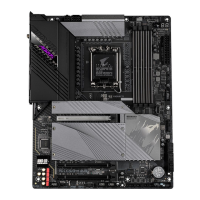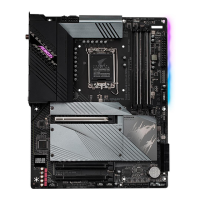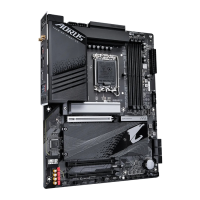- 39 -
Supplier's Declaration of Conformity
47 CFR § 2.1077 Compliance Information
Product Name: Motherboard
Trade Name: GIGABYTE
Model Number: Z690 AERO G/Z690 AERO G DDR4
Responsible Party – U.S. Contact Information: G.B.T. Inc.
Address: 17358 Railroad street, City Of Industry, CA91748
Tel.: 1-626-854-9338
Internet contact information: https://www.gigabyte.com
FCC Compliance Statement:
This device complies with Part 15 of the FCC Rules, Subpart B, Unintentional Radiators.
Operation is subject to the following two conditions: (1) This device may not cause harmful interference, and (2) this
device must accept any interference received, including interference that may cause undesired operation.
Regulatory Notices
United States of America, Federal Communications Commission Statement
Antenna use:
In order to comply with FCC RF exposure limits, low gain integrated
antennas should be located at a minimum distance of 7.9 inches (20 cm)
or more from the body of all persons.
Explosive Device Proximity Warning
Warning: Do not operate a portable transmitter (such as a wireless network
device) near unshielded blasting caps or in an explosive environment
unless the device has been modied to be qualied or such use.
Antenna Warning
The wireless adapter is not designed for use with high-gain antennas.
Use On Aircraft Caution
Caution: Regulations of the FCC and FAA prohibit airborne operation of
radio-frequency wireless devices because their signals could interfere with
critical aircraft instruments.
Other Wireless Devices
Safety Notices for Other Devices in the Wireless Network: Refer to the
documentation supplied with wireless Ethernet adapters or other devices
in the wireless network.
Canada, Canada-Industry Notice:
This device complies with Industr y Can ada license-exempt RSS
standard(s). Operation is subject to the ollowing two conditions:
(1) this device may not cause interference, and
(2) this device must accept any interference, including interference that
may cause undesired operation of the device.
Cet apparei l est conforme aux normes Canada d'Industrie de RSS
permis-exempt. L'utilisation est assujetti aux deux conditions suivantes:
(1) le dispositi ne doit pas produire de brouillage préjudiciable, et
(2) ce dispositif doit accepter tout brouillage reçu, y compris un brouillage
susceptible de provoquer un fonctionnement indésirable.
Caution: WhenusingIEEE 802.11a wirelessLAN, thisproductis restricted
to indoor use due to its operation in the 5.15-to 5.25-GHz requency
range. Industry Canada requires this product to be used indoors for the
requency range o 5.15 GHz to 5.25 GHz to reduce the potential or
harmful interference to co-channel mobile satellite systems. High power
radar is allocated as the primary user o the 5.25-to 5.35-GHz and 5.65 to
5.85-GHz bands. These radar stations can cause intererence with and/or
damage to this device. The maximum allowed antenna gain for use with
this device is 6dBi in order tocomply with the E.I.R.P limit for the 5.25-to
5.35 and 5.725 to 5.85 GHz requency rangein point-to-point operation.To
comply with RF exposure requirements all antennas should be locatedat a
minimum distance of 20cm, or the minimum separation distance allowed
by the module approval, from the body of all persons.
Attention: l'utilisation d'un réseau sans l IEEE802.11a est restreinte à
une utilisation en intérieur à cause du onctionnement dansla bande de
réquence 5.15-5.25 GHz. Industry Canada requiert que ce produit soit
utilisé à l'intérieur des bâtiments pour la bande de réquence 5.15-5.25
GHz an de réduire les possibilités d'interérences nuisibles aux canaux
co-existants des systèmes de transmission satellites. Les radars de
puissances ont ait l'objet d'une allocation primaire de réquences dans
les bandes 5.25-5.35 GHz et 5.65-5.85 GHz. Ces stations radar peuvent
créer des interférences avec ce produit et/ou lui être nuisible. Le gain
d'antenne maximum permissible pour une utilisation avec ce produit
est de 6 dBi an d'être conorme aux limites de puissance isotropique
rayonnéeéquivalente (P.I.R.E.) applicable dans les bandes5.25-5.35 GHz
et 5.725-5.85 GHz en onctionnement point-à-point.Pour se conormer aux
conditions d'exposition de RFtoutes les antennes devraient êtrelocalisées
à une distance minimum de 20 cm, ou la distance de séparation minimum
permise par l'approbation du module, du corps de toutes les personnes.
Under IndustryCanada regulations, this radio transmitter may onlyoperate
using an antenna of a type and maximum (or lesser) gain approved for
the transmitter by Industry Canada. To reduce potential radio interference
to other users, the antenna type and its gain should be chosen so that
the equivalent isotropically radiated power (e.i.r.p.) is not more than that
necessary for successful communication.
Conormément à la réglementationd'Industrie Canada, le présentémetteur
radio peut fonctionner avec une antenne d'un type et d'un gain maximal
(ou inférieur) approuvé pour l'émetteur par Industrie Canada. Dans le
but de réduire les risques de brouillage radio électrique à l'intention des
autres utilisateurs, il faut choisir le type d'antenne et son gain de sorte
que la puissance isotrope rayonnée équivalente (p.i.r.e.) ne dépasse pas
l'intensiténécessaire à l'établissement d'une communication satisaisante.
The FCC with its action in ET Docket 96-8 has adopted a safety standard for human exposure to radio frequency (RF) electromagnetic energy emitted
by FCC certied equipment. The Intel PRO/Wireless 5000 LAN products meet the Human Exposure limits ound in OET Bulletin 65, 2001, and ANSI/
IEEE C95.1, 1992. Proper operation of this radio according to the instructions found in this manual will result in exposure substantially below the FCC's
recommended limits.
The following safety precautions should be observed:
• Do not touch or move antenna while the unit is transmitting or receiving.
• Do not hold any component containing the radio such that the antenna is very close or touching any exposed parts of the body, especially the face
or eyes, while transmitting.
• Do not operate the radio or attempt to transmit data unless the antenna is connected; if not, the radio may be damaged.
• Use in specic environments:
- The use o wireless devices in hazardous locations is limited by the constraints posed by the saety directors o such environments.
- The use of wireless devices on airplanes is governed by the Federal Aviation Administration (FAA).
- The use of wireless devices in hospitals is restricted to the limits set forth by each hospital.
